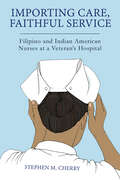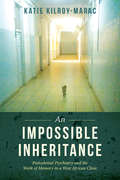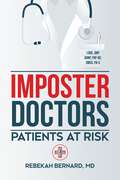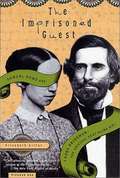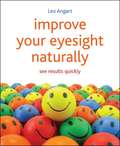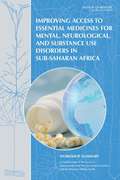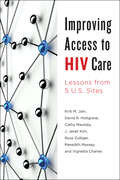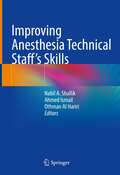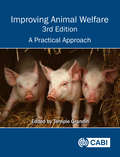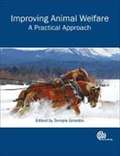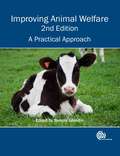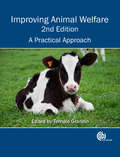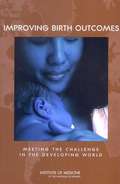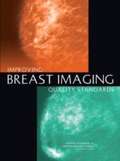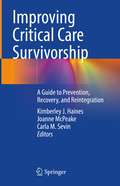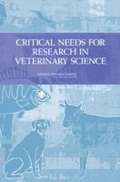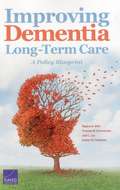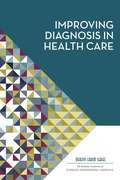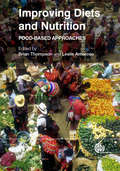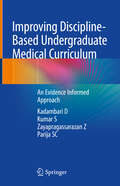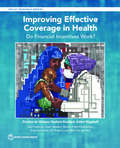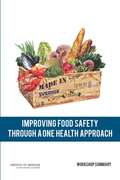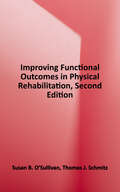- Table View
- List View
Importing Care, Faithful Service: Filipino and Indian American Nurses at a Veterans Hospital (Critical Issues in Health and Medicine)
by Stephen M. CherryEvery year thousands of foreign-born Filipino and Indian nurses immigrate to the United States. Despite being well trained and desperately needed, they enter the country at a time, not unlike the past, when the American social and political climate is once again increasingly unwelcoming to them as immigrants. Drawing on rich ethnographic and survey data, collected over a four-year period, this study explores the role Catholicism plays in shaping the professional and community lives of foreign-born Filipino and Indian American nurses in the face of these challenges, while working at a Veterans hospital. Their stories provide unique insights into the often-unseen roles race, religion and gender play in the daily lives of new immigrants employed in American healthcare. In many ways, these nurses find themselves foreign in more ways than just their nativity. Seeing nursing as a religious calling, they care for their patients, both at the hospital and in the wider community, with a sense of divine purpose but must also confront the cultural tensions and disconnects between how they were raised and trained in another country and the legal separation of church and state. How they cope with and engage these tensions and disconnects plays an important role in not only shaping how they see themselves as Catholic nurses but their place in the new American story.
An Impossible Inheritance: Postcolonial Psychiatry and the Work of Memory in a West African Clinic
by Katie Kilroy-MaracWeaving sound historical research with rich ethnographic insight, An Impossible Inheritance tells the story of the emergence, disavowal, and afterlife of a distinctive project in transcultural psychiatry initiated at the Fann Psychiatric Clinic in Dakar, Senegal during the 1960s and 1970s. Today’s clinic remains haunted by its past and Katie Kilroy-Marac brilliantly examines the complex forms of memory work undertaken by its affiliates over a sixty year period. Through stories such as that of the the ghost said to roam the clinic’s halls, the mysterious death of a young doctor sometimes attributed to witchcraft, and the spirit possession ceremonies that may have taken place in Fann’s courtyard, Kilroy-Marac argues that memory work is always an act of the imagination and a moral practice with unexpected temporal, affective, and political dimensions. By exploring how accounts about the Fann Psychiatric Clinic and its past speak to larger narratives of postcolonial and neoliberal transformation, An Impossible Inheritance examines the complex relationship between memory, history, and power within the institution and beyond.
Imposter Doctors: Patients at Risk
by Rebekah BernardWhen you experience a medical emergency, you expect to be treated by a licensed physician with expertise in your condition. What happens when you look up from your hospital gurney to find that the doctor has been replaced by a non-physician practitioner w
The Imprisoned Guest: Samuel Howe and Laura Bridgman, the Original Deaf-Blind Girl
by Elisabeth GitterDid you ever wonder what inspired Helen Keller's mother to have such high hopes for her daughter? The answer is Laura Bridgman, the original deaf-blind girl who inspired Charles Darwin to visit her and also write about her in American Notes.
Improve Your Eyesight Naturally: See Results Quickly
by Leo AngartThis title details strategies designed to improve your eyesight by literally exercising your ability to see. Leo's approach is very specific and targets each degree of vision problem. He explains how you can tone your eye-muscles, release tension, and build up energy in order to regain your natural eyesight.
Improving Access to Essential Medicines for Mental, Neurological, and Substance Use Disorders in Sub-Saharan Africa: Workshop Summary
by Diane E. PankevichIn 2011 the Grand Challenges in Global Mental Health initiative identified priorities that have the potential to make a significant impact on the lives of people with mental, neurological, and substance use disorders. Reduction of the cost and improvement of the supply of effective medicines was highlighted as one of the top five challenges. For low- and middle-income countries, improving access to appropriate essential medicines can be a tremendous challenge and a critical barrier to scaling up quality care for mental, neurological, and substance use disorders. Reduction of cost and improvement of the supply of effective medicines has the potential to significantly impact the lives of patients with these disorders. "Improving Access to Essential Medicines for Mental, Neurological, and Substance Use Disorders in Sub-Saharan Africa" is the summary of a workshop convened by the Institute of Medicine Neuroscience Forum in January 2014 in Addis Ababa, Ethiopia to discuss opportunities for achieving long-term affordable access to medicines for these disorders. This report examines challenges and opportunities for improving access to essential medicines in four critical areas: demand, selection, supply chains, and financing and pricing. The report also discusses successful activities that increase access to essential medicines both within Sub-Saharan Africa and in other developing countries, and considers the role of governments, nongovernmental organizations, and private groups in procurement of essential medicines for mental, neurological, and substance use disorders.
Improving Access to HIV Care: Lessons from Five U.S. Sites
by Kriti M. Jain David R. Holtgrave Cathy Maulsby J. Janet Kim Rose Zulliger Meredith Massey Vignetta CharlesEffective strategies for identifying people living with HIV and helping them receive ongoing medical care.The availability of combination antiretroviral therapy has changed the lives of millions of people living with HIV (PLWH), for whom a once fatal infection can now be a manageable chronic disease. Yet only 30 percent of PLWH in the United States are virally suppressed, and significant gaps in access to care persist. While programs to boost linkage to and retention in HIV care are critical to improving the health of PLWH, efforts to evaluate these programs are surprisingly scarce. Using cutting-edge implementation science, this book tackles the issue of how to better link and retain PLWH in ongoing primary medical care. A multipart case study examines successful strategies and provides detailed profiles of the organizations involved and their processes for reaching, linking, and retaining PLWH. Barriers to and facilitators of implementation are explored qualitatively, network analysis is used to assess changes in interagency collaboration among organizations serving PLWH, and evidence-based recommendations are offered for improving linkage to HIV care in the U.S.
Improving Access to Oral Health Care for Vulnerable and Underserved Populations
by Committee on Oral Health Access to ServicesAccess to oral health care is essential to promoting and maintaining overall health and well-being, yet only half of the population visits a dentist each year. Poor and minority children are less likely to have access to oral health care than are their nonpoor and nonminority peers. Older adults, people who live in rural areas, and disabled individuals, uniformly confront access barriers, regardless of their financial resources. The consequences of these disparities in access to oral health care can lead to a number of conditions including malnutrition, childhood speech problems, infections, diabetes, heart disease, and premature births. Improving Access to Oral Health Care for Vulnerable and Underserved Populations examines the scope and consequences of inadequate access to oral health services in the United States and recommends ways to combat the economic, structural, geographic, and cultural factors that prevent access to regular, quality care. The report suggests changing funding and reimbursement for dental care; expanding the oral health work force by training doctors, nurses, and other nondental professionals to recognize risk for oral diseases; and revamping regulatory, educational, and administrative practices. It also recommends changes to incorporate oral health care into overall health care. These recommendations support the creation of a diverse workforce that is competent, compensated, and authorized to serve vulnerable and underserved populations across the life cycle. The recommendations provided in Improving Access to Oral Health Care for Vulnerable and Underserved Populations will help direct the efforts of federal, state, and local government agencies; policy makers; health professionals in all fields; private and public health organizations; licensing and accreditation bodies; educational institutions; health care researchers; and philanthropic and advocacy organizations.
Improving Anesthesia Technical Staff’s Skills
by Ahmed Ismail Nabil A. Shallik Othman Al HaririThis book showcases state-of-the-art techniques as well as various clinical, technical and non-technical skills. By highlighting the reliability of the new techniques compared to standard clinical methods of predicting peri-operative problems in the operating rooms, it enables better management and utilization of operating rooms. The combined use of knowledge and technology has resulted in improvements in healthcare services that are not achieved by the use of the best technology but by the best use of technology. Medicine is a continually advancing science, and healthcare providers constantly enhance their knowledge and develop their skills. While knowledge sharing is vital for humanity, technology has made the application of medical knowledge more versatile and more widely available. Written by leading anesthesiologists, anesthesia technicians and technologists, the book addresses the need for a ready reference for anesthesiologists, as well as anesthesia technical staff. It provides an easily navigated, pocket-sized reference resource featuring pictures, tables and schema.
Improving Animal Welfare: A Practical Approach
by Madonna Benjamin Courtney Lynd Daigle Derek Donkin Anne Marie Anne Marie Lily N. Edwards-Callaway Wendy K Fulwider Camie Heleski Hubert J. Karreman David Main Amy McLean David J Mellor Siobhan Mullan Bernard Rollin Jeffrey Rushen Jan Shearer Kevin Stafford Janice Swanson Kurt Vogel Helen Whay Tina Widowski Jennifer Woods Steven Yik Upinder Kaur Richard M. Voyles Shawn DonkinCompletely revised, updated and with four new chapters on sustainability, new technologies, precision agriculture and the future of animal welfare, the third edition of this highly successful textbook: · Is edited by an outstanding world expert on animal welfare. · Emphasizes throughout the importance of measuring conditions that compromise welfare, such as lameness, heat stress, body condition, and bruises during transport. · Combines scientific information with practical recommendations for use on commercial operations. · Reviews practical information on livestock handling, euthanasia, slaughter, pain relief, and assessments of abnormal behavior. Improving Animal Welfare: A Practical Approach remains essential reading for students and practitioners of ethology, animal and veterinary science, veterinary medicine, as well as those working directly with farm animals and committed to improving their welfare.
Improving Animal Welfare
by Temple GrandinNew legislation on animal welfare standards has created the need for welfare programmes to be implemented on farms, during transportation, and in slaughter plants. While there is a wealth of information on animal behaviour, ethics and factors effecting welfare, there is little to guide veterinarians and managers in evaluating animal welfare and improving it. This textbook aims to help those working with animals to apply practical methods for improving welfare, bridging the gap between scientific research and practical application. Drawing on the editor's extensive experience in teaching and auditing, and contributions from international experts, this book provides a guide to practical evaluation and auditing of welfare problems, emphasizing the importance of measuring conditions that compromise welfare. Key Features Written by a leading authority on the subject with contributions from industry experts Provides a strongly practical review of the topic and how to apply research where it makes a difference Ideal guide for veterinarians and veterinary students and welfare auditing and officer training, and students in animal sciences
Improving Animal Welfare
by David Mellor David Main Jennifer Woods Temple Grandin Kevin Stafford Jeff Hill Bernard Rollin Camie Heleski Janice Swanson Amy Mclean Lily Nowell Edwards Anne De Passillé Jeffrey Rushen Jan Shearer Helen Whay Tina WidowskiBy taking an entirely practical approach, this textbook aims to help those working with animals to apply methods for improving welfare, bridging the gap between scientific research and practical application. This book provides a guide to practical evaluation and auditing of welfare problems for farmed animals, emphasizing the importance of measuring conditions that compromise welfare such as lameness, or the use of electric goads. This second edition is fully updated with new literature, new, up to date coverage of pain management, and the addition of a new chapter on animal welfare in organic farming systems.
Improving Animal Welfare: A Practical Approach
by Anne De Passillé Lily Nowell Edwards Camie Heleski Jeff Hill David Main Amy McLean David Mellor Bernard Rollin Jeffrey Rushen Jan Shearer Kevin Stafford Janice Swanson Helen Whay Tina Widowski Jennifer WoodsBy taking an entirely practical approach, this textbook aims to help those working with animals to apply methods for improving welfare, bridging the gap between scientific research and practical application. This book provides a guide to practical evaluation and auditing of welfare problems for farmed animals, emphasizing the importance of measuring conditions that compromise welfare such as lameness, or the use of electric goads. This second edition is fully updated with new literature, new, up to date coverage of pain management, and the addition of a new chapter on animal welfare in organic farming systems.
Improving Birth Outcomes: Meeting The Challenge In The Developing World
by Committee on Improving Birth OutcomesBirth outcomes have improved dramatically worldwide in the past 40 years. Yet there is still a large gap between the outcomes in developing and developed countries. This book addresses the steps needed to reduce that gap. It reviews the available statistics of low birth weight, prematurity, and birth defects; reviews current knowledge and practices of a healthy pregnancy, identifies cost-effective opportunities for improving birth outcomes and supporting families with an infant handicapped by birth problems, and recommens priority research, capacity building, and institutional and global efforts to reduce adverse birth outcomes in developing countries. The committee has based its study on data and information from several developing countries, and provides recommendations that can assist the March of Dimes, Centers for Disease Control and Prevention, and NIH in tailoring their international program and forging new partnerships to reduce the mortality and morbidity associated with adverse birth outcomes.
Improving Breast Imaging Quality Standards
by Institute of Medicine National Research Council of the National AcademiesMammography is an important tool for detecting breast cancer at an early stage. When coupled with appropriate treatment, early detection can reduce breast cancer mortality. At the request of Congress, the Food and Drug Administration (FDA) commissioned a study to examine the current practice of mammography and breast cancer detection, with a focus on the FDA’s oversight via the Mammography Quality Standards Act (MQSA), to identify areas in need of improvement. Enacted in 1993, MQSA provides a general framework for ensuring national quality standards in facilities performing screening mammography, requires that each mammography facility be accredited and certified, and mandates that facilities will undergo annual inspections. This book recommends strategies for achieving continued progress in assuring mammography quality, including changes to MQSA regulation, as well as approaches that do not fall within the purview of MQSA. Specifically, this book provides recommendations aimed at improving mammography interpretation; revising MQSA regulations, inspections, and enforcement; ensuring an adequate workforce for breast cancer screening and diagnosis; and improving breast imaging quality beyond mammography.
Improving Critical Care Survivorship: A Guide to Prevention, Recovery, and Reintegration
by Kimberley J. Haines Joanne McPeake Carla M. SevinThis book provides a comprehensive overview of improving critical care survivorship. Comprised of four sections, the text presents interventions that can be used to improve patient outcomes and reduce the burden of post-intensive care syndrome across the arc of care, from the ICU to returning home. The first section of the text focuses on preventing adverse outcomes in the ICU, with an emphasis on implementing early mobilization, engaging and supporting families, and employing various forms of therapy. The second section revolves around enhancing recovery post-ICU, focusing on physical and neurocognitive rehabilitation programs, peer support, and poly-pharmacy management. Community reintegration is the subject of the third section, with emphasis on socioeconomic reintegration, healthcare utilization, and volunteerism in ICU recovery. The book concludes with a section on future considerations, specifically spotlighting preliminary ideas that address long-term sequelae and international collaboration to solve critical care challenges. Written by experts in the field, Improving Critical Care Survivorship: A Guide for Prevention, Recovery, and Reintegration is a valuable resource for critical care clinicians and researchers interested in improving the quality of patient survival after ICU admission.
IMPROVING DATA TO ANALYZE Food and Nutrition Policies
by National Research Council of the National AcademiesThe National Academies Press (NAP)--publisher for the National Academies--publishes more than 200 books a year offering the most authoritative views, definitive information, and groundbreaking recommendations on a wide range of topics in science, engineering, and health. Our books are unique in that they are authored by the nation's leading experts in every scientific field.
Improving Dementia Long-Term Care: A Policy Blueprint
by Regina A. Shih Thomas W. Concannon Jodi L. Liu Esther M. FriedmanIn 2010, 15 percent of Americans older than age 70 had dementia. By 2050, the number of new dementia cases among those 65 and older is expected to double. This blueprint outlines policy options to help decisionmakers improve dementia long-term services and supports (LTSS) by promoting earlier detection, improving access to LTSS, promoting person- and caregiver-centered care, supporting caregivers, and reducing dementia LTSS costs.
Improving Diagnosis in Health Care
by Erin P. BaloghGetting the right diagnosis is a key aspect of health care - it provides an explanation of a patient's health problem and informs subsequent health care decisions. The diagnostic process is a complex, collaborative activity that involves clinical reasoning and information gathering to determine a patient's health problem. According to Improving Diagnosis in Health Care, diagnostic errors-inaccurate or delayed diagnoses-persist throughout all settings of care and continue to harm an unacceptable number of patients. It is likely that most people will experience at least one diagnostic error in their lifetime, sometimes with devastating consequences. Diagnostic errors may cause harm to patients by preventing or delaying appropriate treatment, providing unnecessary or harmful treatment, or resulting in psychological or financial repercussions. The committee concluded that improving the diagnostic process is not only possible, but also represents a moral, professional, and public health imperative. "Improving Diagnosis in Health Care" a continuation of the landmark Institute of Medicine reports "To Err Is Human" (2000) and "Crossing the Quality Chasm" (2001) finds that diagnosis-and, in particular, the occurrence of diagnostic errorsa "has been largely unappreciated in efforts to improve the quality and safety of health care. Without a dedicated focus on improving diagnosis, diagnostic errors will likely worsen as the delivery of health care and the diagnostic process continue to increase in complexity. Just as the diagnostic process is a collaborative activity, improving diagnosis will require collaboration and a widespread commitment to change among health care professionals, health care organizations, patients and their families, researchers, and policy makers. The recommendations of "Improving Diagnosis in Health Care" contribute to the growing momentum for change in this crucial area of health care quality and safety. "
Improving Diets and Nutrition
by Leslie Amoroso Brian ThompsonNutrition-sensitive, food-based approaches towards hunger and malnutrition are effective, sustainable and long-term solutions. This book discusses the policy, strategic, methodological, technical and programmatic issues associated with such approaches, proposes "best practices" for the design, targeting, implementation and evaluation of specific nutrition-sensitive, food-based interventions and for improved methodologies for evaluating their efficacy and cost-effectiveness, and provides practical lessons for advancing nutrition-sensitive food-based approaches for improving nutrition at policy and programme level.
Improving Diets and Nutrition: Food-based Approaches (Co-published With The Food And Agriculture Organization Of The United Nations (fao) Ser.)
by Brian Thompson Leslie AmorosoNutrition-sensitive, food-based approaches towards hunger and malnutrition are effective, sustainable and long-term solutions. This book discusses the policy, strategic, methodological, technical and programmatic issues associated with such approaches, proposes “best practices” for the design, targeting, implementation and evaluation of specific nutrition-sensitive, food-based interventions and for improved methodologies for evaluating their efficacy and cost-effectiveness, and provides practical lessons for advancing nutrition-sensitive food-based approaches for improving nutrition at policy and programme level.
Improving Discipline-Based Undergraduate Medical Curriculum: An Evidence Informed Approach
by Parija Sc Zayapragassarazan Z Kumar S Kadambari DThe past few decades have seen the increasing use of evidence in all aspects of healthcare. The concept of evidence-informed healthcare began in the 1990s as evidence-informed practice, and has since become widely accepted. It is also accepted that the training of medical graduates must be informed by evidence obtained from educational research. This book utilizes an evidence-informed approach to improve discipline-based undergraduate medical curricula. Discipline-based undergraduate medical curricula represent a widely adopted choice for undergraduate medical education around the world. However, there have been criticisms leveled against the discipline-based approach. One of the shortcomings cited is that students are insufficiently equipped to meet the challenges of today’s healthcare. As a result, various strategies have been proposed. One option, currently in vogue, is the outcome-based approach, wherein the exit behaviors of medical graduates are explicitly examined and used to guide the educational process. The shortcomings present in discipline-based undergraduate medical curricula can be overcome by the strengths of these strategies. This book recommends improving discipline-based undergraduate medical curricula by combining several strategies, including the adoption of an outcome-based approach and the use of evidence-informed implementable solutions. The book is relevant for all faculty, administrators and policymakers involved in undergraduate medical education, and can also be used as a resource for faculty development.
Improving Effective Coverage in Health: Do Financial Incentives Work? (Policy Research Reports)
by Damien de Walque Eeshani Kandpal Adam Wagstaff Friedman Moritz Piatti-Fünfkirchen Anja Sautmann Gil Shapira Ellen Van de PoelIn many low- and middle-income countries, health coverage has improved dramatically in the past two decades, but health outcomes have not. As such, effective coverage—a measure of service delivery that meets a minimum standard of quality—remains unacceptably low. Improving Effective Coverage in Health examines one specific policy approach to improving effective coverage: financial incentives in the form of performance-based financing (PBF), a package reform that typically includes performance pay to frontline health workers as well as facility autonomy, transparency, and community engagement. This Policy Research Report draws on a rich set of rigorous studies and new analysis. When compared with business-as-usual, in low-income settings with centralized health systems PBF can result in substantial gains in effective coverage. However, the relative benefits of PBF—the performance pay component in particular—are less clear when it is compared with two alternative approaches, direct facility financing, which provides operating budgets to frontline health services with facility autonomy on allocation, but not performance pay, and demand-side financial support for health services (that is, conditional cash transfers and vouchers). Although PBF often results in improvements on the margins, closing the substantial gaps in effective health coverage is not yet within reach for many countries. Nonetheless, important lessons and experiences from the rollout of PBF over the past decade can guide health financing into the future. In particular, to be successful, health financing reform may need to pivot from performance pay while retaining the elements of direct facility financing, autonomy, transparency, and community engagement.
Improving Food Safety Through a One Health Approach
by Eileen R. ChoffnesGlobalization of the food supply has created conditions favorable for the emergence, reemergence, and spread of food-borne pathogens-compounding the challenge of anticipating, detecting, and effectively responding to food-borne threats to health. In the United States, food-borne agents affect 1 out of 6 individuals and cause approximately 48 million illnesses, 128,000 hospitalizations, and 3,000 deaths each year. This figure likely represents just the tip of the iceberg, because it fails to account for the broad array of food-borne illnesses or for their wide-ranging repercussions for consumers, government, and the food industry-both domestically and internationally. A One Health approach to food safety may hold the promise of harnessing and integrating the expertise and resources from across the spectrum of multiple health domains including the human and veterinary medical and plant pathology communities with those of the wildlife and aquatic health and ecology communities. The IOM's Forum on Microbial Threats hosted a public workshop on December 13 and 14, 2011 that examined issues critical to the protection of the nation's food supply. The workshop explored existing knowledge and unanswered questions on the nature and extent of food-borne threats to health. Participants discussed the globalization of the U. S. food supply and the burden of illness associated with foodborne threats to health; considered the spectrum of food-borne threats as well as illustrative case studies; reviewed existing research, policies, and practices to prevent and mitigate foodborne threats; and, identified opportunities to reduce future threats to the nation's food supply through the use of a "One Health" approach to food safety. Improving Food Safety Through a One Health Approach: Workshop Summary covers the events of the workshop and explains the recommendations for future related workshops.
Improving Functional Outcomes in Physical Rehabilitation
by Susan B. O'Sullivan Thomas J. SchmitzAchieve the best functional outcomes for your patients. Here is a practical, step-by-step guide to understanding the treatment process and selecting the most appropriate intervention for your patient. Superbly illustrated, in-depth coverage shows you how to identify functional deficits, determine what treatments are appropriate, and then implement them to achieve the best functional outcome for your patients. This one-of-a-kind resource features case studies in the text accompanied by videos online at DavisPlus that demonstrate how the interventions selected make a difference in your patients’ lives.
